Business Strategy: Severstal's Acquisitions in a Turbulent Market
VerifiedAdded on 2023/01/20
|12
|3303
|78
Report
AI Summary
This report critically examines Severstal's acquisition strategy within the context of the turbulent global steel industry, focusing on its motives, suitability, and impact on the company's international strategy. The analysis begins with an overview of the current state of the steel industry, highlighting challenges such as economic recession, oversupply, and political factors including trade wars and protectionism, which are addressed using PEST analysis. The report then explores Severstal's strategic responses, particularly its mergers and acquisitions, analyzing their effectiveness through the Porter Diamond Model to assess factor conditions, supporting industries, demand conditions, and competitive intensity. Key motives for Severstal's acquisitions, such as reducing raw material costs, integrating production, and expanding global presence, are discussed. The report evaluates the advantages and disadvantages of this strategy, considering its implications for Severstal's competitiveness and operational efficiency. The report also addresses social and technological factors influencing the steel industry and the benefits of acquisitions in these areas. Overall, the report provides a comprehensive understanding of Severstal's strategic decisions and their outcomes in a complex global market.
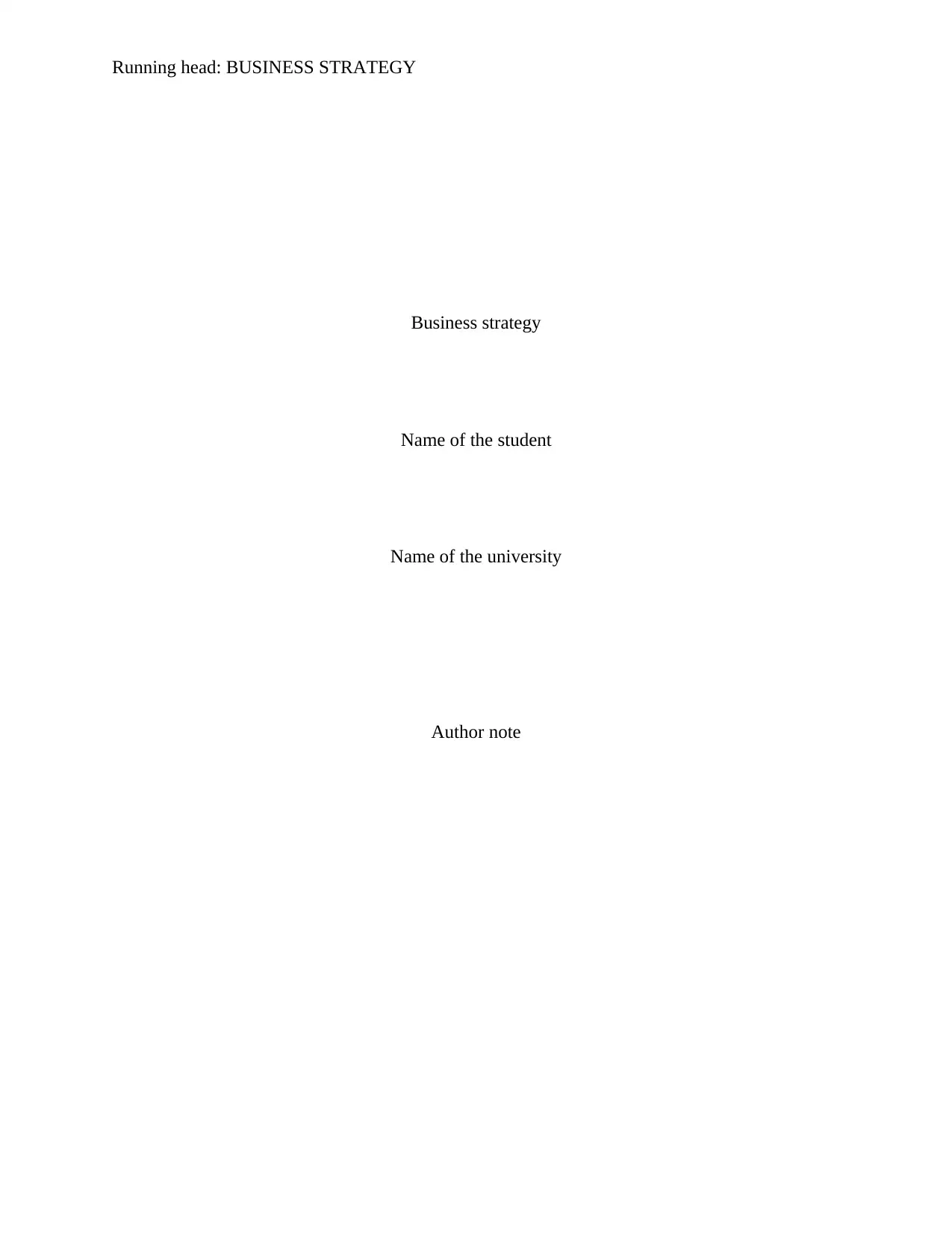
Running head: BUSINESS STRATEGY
Business strategy
Name of the student
Name of the university
Author note
Business strategy
Name of the student
Name of the university
Author note
Paraphrase This Document
Need a fresh take? Get an instant paraphrase of this document with our AI Paraphraser
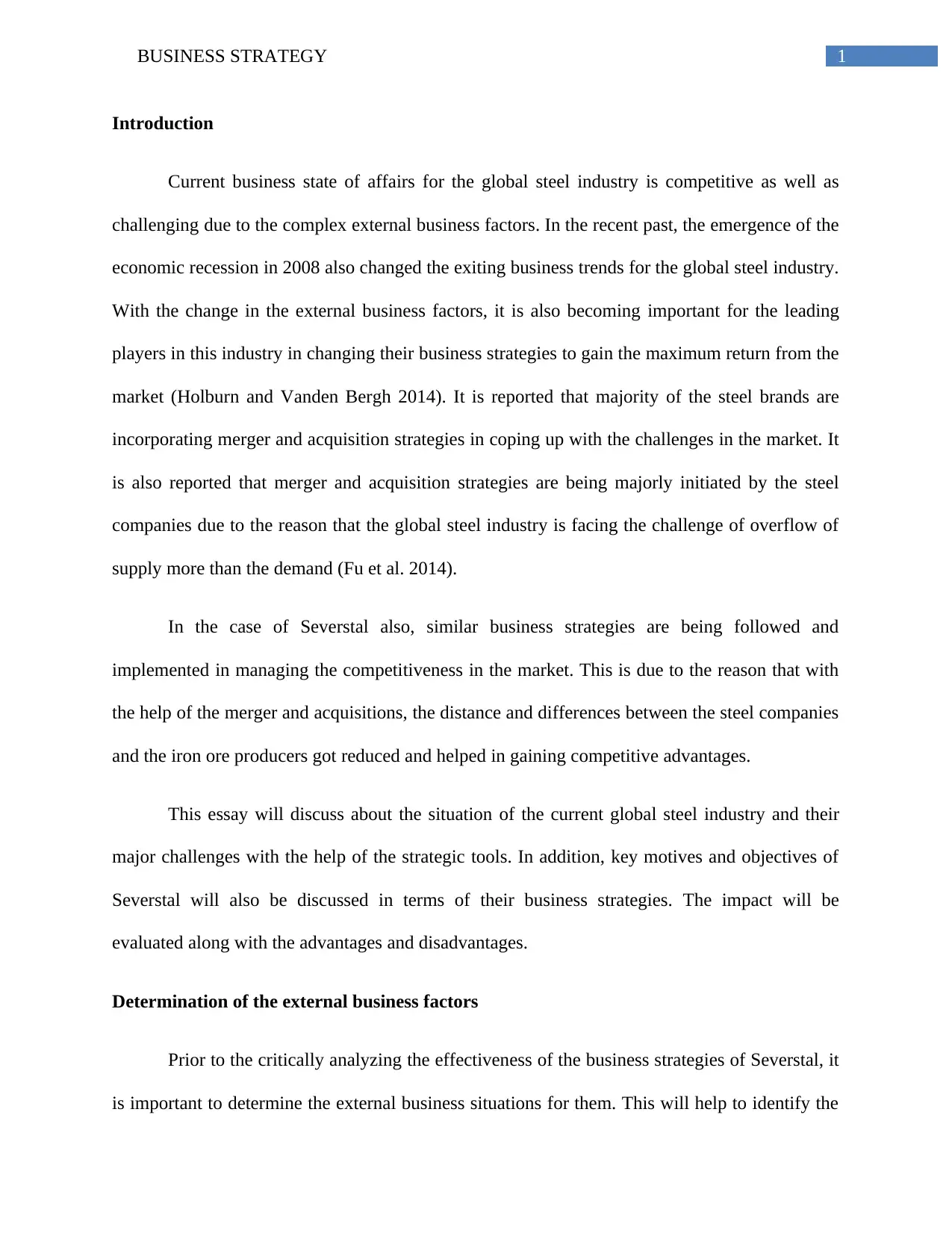
1BUSINESS STRATEGY
Introduction
Current business state of affairs for the global steel industry is competitive as well as
challenging due to the complex external business factors. In the recent past, the emergence of the
economic recession in 2008 also changed the exiting business trends for the global steel industry.
With the change in the external business factors, it is also becoming important for the leading
players in this industry in changing their business strategies to gain the maximum return from the
market (Holburn and Vanden Bergh 2014). It is reported that majority of the steel brands are
incorporating merger and acquisition strategies in coping up with the challenges in the market. It
is also reported that merger and acquisition strategies are being majorly initiated by the steel
companies due to the reason that the global steel industry is facing the challenge of overflow of
supply more than the demand (Fu et al. 2014).
In the case of Severstal also, similar business strategies are being followed and
implemented in managing the competitiveness in the market. This is due to the reason that with
the help of the merger and acquisitions, the distance and differences between the steel companies
and the iron ore producers got reduced and helped in gaining competitive advantages.
This essay will discuss about the situation of the current global steel industry and their
major challenges with the help of the strategic tools. In addition, key motives and objectives of
Severstal will also be discussed in terms of their business strategies. The impact will be
evaluated along with the advantages and disadvantages.
Determination of the external business factors
Prior to the critically analyzing the effectiveness of the business strategies of Severstal, it
is important to determine the external business situations for them. This will help to identify the
Introduction
Current business state of affairs for the global steel industry is competitive as well as
challenging due to the complex external business factors. In the recent past, the emergence of the
economic recession in 2008 also changed the exiting business trends for the global steel industry.
With the change in the external business factors, it is also becoming important for the leading
players in this industry in changing their business strategies to gain the maximum return from the
market (Holburn and Vanden Bergh 2014). It is reported that majority of the steel brands are
incorporating merger and acquisition strategies in coping up with the challenges in the market. It
is also reported that merger and acquisition strategies are being majorly initiated by the steel
companies due to the reason that the global steel industry is facing the challenge of overflow of
supply more than the demand (Fu et al. 2014).
In the case of Severstal also, similar business strategies are being followed and
implemented in managing the competitiveness in the market. This is due to the reason that with
the help of the merger and acquisitions, the distance and differences between the steel companies
and the iron ore producers got reduced and helped in gaining competitive advantages.
This essay will discuss about the situation of the current global steel industry and their
major challenges with the help of the strategic tools. In addition, key motives and objectives of
Severstal will also be discussed in terms of their business strategies. The impact will be
evaluated along with the advantages and disadvantages.
Determination of the external business factors
Prior to the critically analyzing the effectiveness of the business strategies of Severstal, it
is important to determine the external business situations for them. This will help to identify the
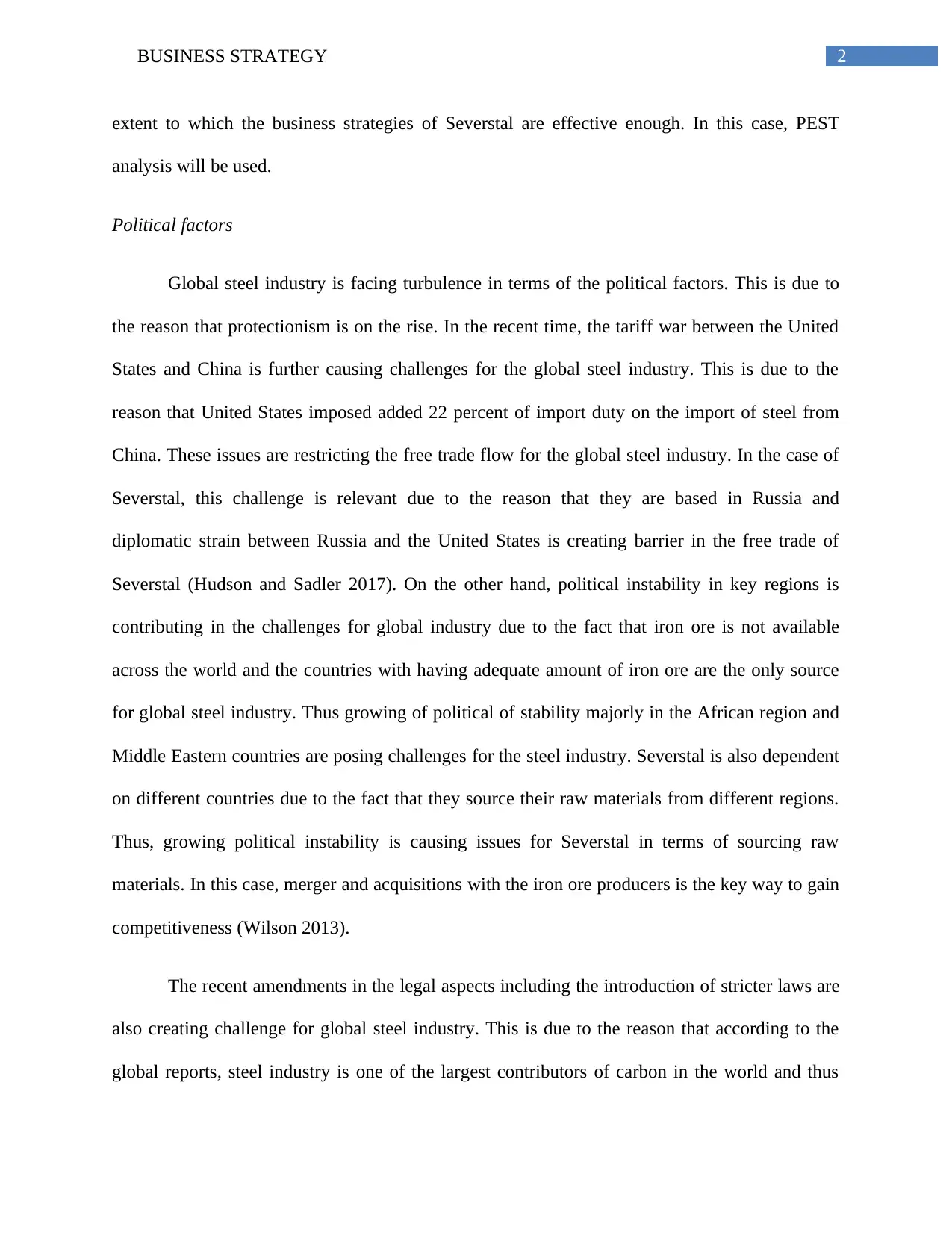
2BUSINESS STRATEGY
extent to which the business strategies of Severstal are effective enough. In this case, PEST
analysis will be used.
Political factors
Global steel industry is facing turbulence in terms of the political factors. This is due to
the reason that protectionism is on the rise. In the recent time, the tariff war between the United
States and China is further causing challenges for the global steel industry. This is due to the
reason that United States imposed added 22 percent of import duty on the import of steel from
China. These issues are restricting the free trade flow for the global steel industry. In the case of
Severstal, this challenge is relevant due to the reason that they are based in Russia and
diplomatic strain between Russia and the United States is creating barrier in the free trade of
Severstal (Hudson and Sadler 2017). On the other hand, political instability in key regions is
contributing in the challenges for global industry due to the fact that iron ore is not available
across the world and the countries with having adequate amount of iron ore are the only source
for global steel industry. Thus growing of political of stability majorly in the African region and
Middle Eastern countries are posing challenges for the steel industry. Severstal is also dependent
on different countries due to the fact that they source their raw materials from different regions.
Thus, growing political instability is causing issues for Severstal in terms of sourcing raw
materials. In this case, merger and acquisitions with the iron ore producers is the key way to gain
competitiveness (Wilson 2013).
The recent amendments in the legal aspects including the introduction of stricter laws are
also creating challenge for global steel industry. This is due to the reason that according to the
global reports, steel industry is one of the largest contributors of carbon in the world and thus
extent to which the business strategies of Severstal are effective enough. In this case, PEST
analysis will be used.
Political factors
Global steel industry is facing turbulence in terms of the political factors. This is due to
the reason that protectionism is on the rise. In the recent time, the tariff war between the United
States and China is further causing challenges for the global steel industry. This is due to the
reason that United States imposed added 22 percent of import duty on the import of steel from
China. These issues are restricting the free trade flow for the global steel industry. In the case of
Severstal, this challenge is relevant due to the reason that they are based in Russia and
diplomatic strain between Russia and the United States is creating barrier in the free trade of
Severstal (Hudson and Sadler 2017). On the other hand, political instability in key regions is
contributing in the challenges for global industry due to the fact that iron ore is not available
across the world and the countries with having adequate amount of iron ore are the only source
for global steel industry. Thus growing of political of stability majorly in the African region and
Middle Eastern countries are posing challenges for the steel industry. Severstal is also dependent
on different countries due to the fact that they source their raw materials from different regions.
Thus, growing political instability is causing issues for Severstal in terms of sourcing raw
materials. In this case, merger and acquisitions with the iron ore producers is the key way to gain
competitiveness (Wilson 2013).
The recent amendments in the legal aspects including the introduction of stricter laws are
also creating challenge for global steel industry. This is due to the reason that according to the
global reports, steel industry is one of the largest contributors of carbon in the world and thus
⊘ This is a preview!⊘
Do you want full access?
Subscribe today to unlock all pages.

Trusted by 1+ million students worldwide
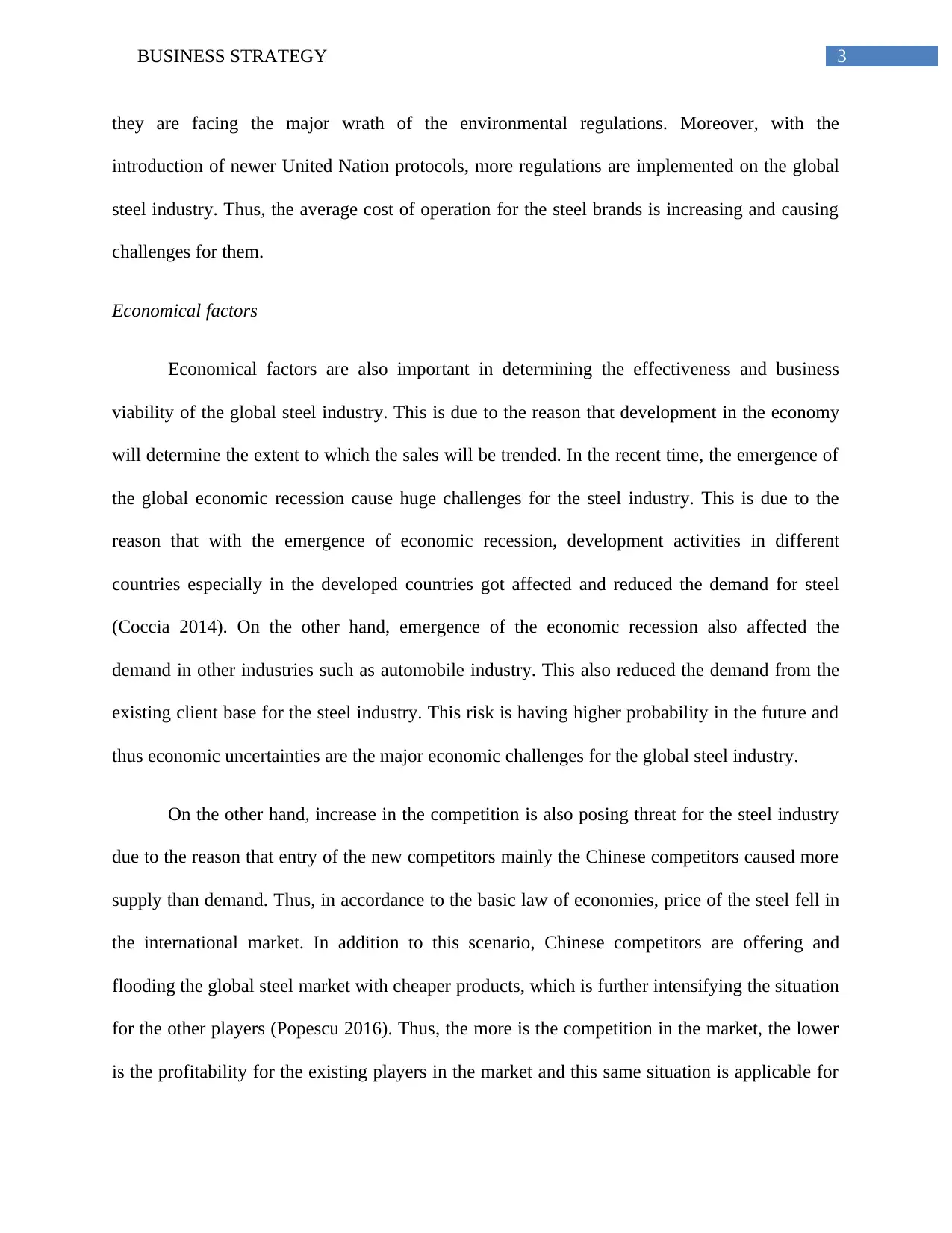
3BUSINESS STRATEGY
they are facing the major wrath of the environmental regulations. Moreover, with the
introduction of newer United Nation protocols, more regulations are implemented on the global
steel industry. Thus, the average cost of operation for the steel brands is increasing and causing
challenges for them.
Economical factors
Economical factors are also important in determining the effectiveness and business
viability of the global steel industry. This is due to the reason that development in the economy
will determine the extent to which the sales will be trended. In the recent time, the emergence of
the global economic recession cause huge challenges for the steel industry. This is due to the
reason that with the emergence of economic recession, development activities in different
countries especially in the developed countries got affected and reduced the demand for steel
(Coccia 2014). On the other hand, emergence of the economic recession also affected the
demand in other industries such as automobile industry. This also reduced the demand from the
existing client base for the steel industry. This risk is having higher probability in the future and
thus economic uncertainties are the major economic challenges for the global steel industry.
On the other hand, increase in the competition is also posing threat for the steel industry
due to the reason that entry of the new competitors mainly the Chinese competitors caused more
supply than demand. Thus, in accordance to the basic law of economies, price of the steel fell in
the international market. In addition to this scenario, Chinese competitors are offering and
flooding the global steel market with cheaper products, which is further intensifying the situation
for the other players (Popescu 2016). Thus, the more is the competition in the market, the lower
is the profitability for the existing players in the market and this same situation is applicable for
they are facing the major wrath of the environmental regulations. Moreover, with the
introduction of newer United Nation protocols, more regulations are implemented on the global
steel industry. Thus, the average cost of operation for the steel brands is increasing and causing
challenges for them.
Economical factors
Economical factors are also important in determining the effectiveness and business
viability of the global steel industry. This is due to the reason that development in the economy
will determine the extent to which the sales will be trended. In the recent time, the emergence of
the global economic recession cause huge challenges for the steel industry. This is due to the
reason that with the emergence of economic recession, development activities in different
countries especially in the developed countries got affected and reduced the demand for steel
(Coccia 2014). On the other hand, emergence of the economic recession also affected the
demand in other industries such as automobile industry. This also reduced the demand from the
existing client base for the steel industry. This risk is having higher probability in the future and
thus economic uncertainties are the major economic challenges for the global steel industry.
On the other hand, increase in the competition is also posing threat for the steel industry
due to the reason that entry of the new competitors mainly the Chinese competitors caused more
supply than demand. Thus, in accordance to the basic law of economies, price of the steel fell in
the international market. In addition to this scenario, Chinese competitors are offering and
flooding the global steel market with cheaper products, which is further intensifying the situation
for the other players (Popescu 2016). Thus, the more is the competition in the market, the lower
is the profitability for the existing players in the market and this same situation is applicable for
Paraphrase This Document
Need a fresh take? Get an instant paraphrase of this document with our AI Paraphraser
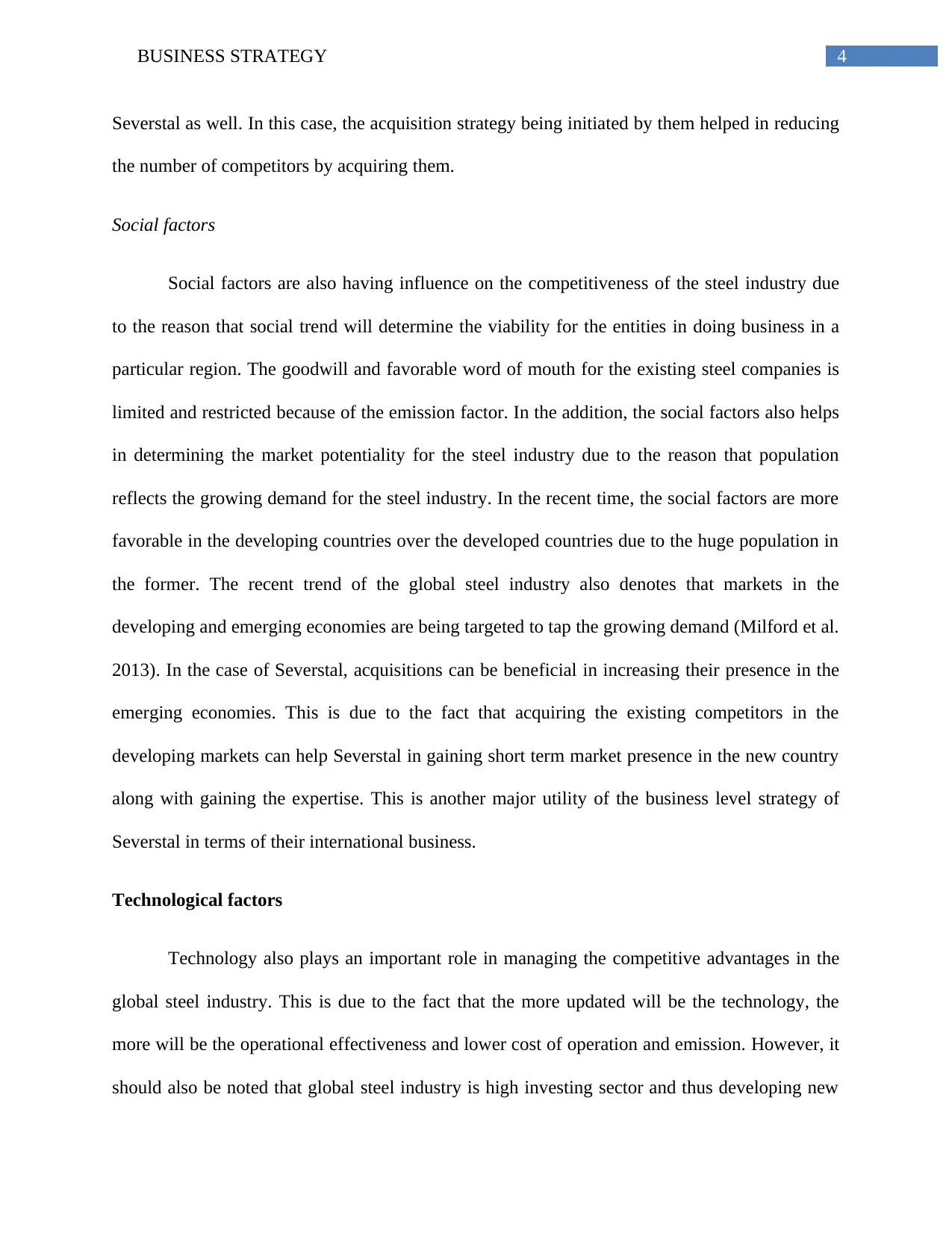
4BUSINESS STRATEGY
Severstal as well. In this case, the acquisition strategy being initiated by them helped in reducing
the number of competitors by acquiring them.
Social factors
Social factors are also having influence on the competitiveness of the steel industry due
to the reason that social trend will determine the viability for the entities in doing business in a
particular region. The goodwill and favorable word of mouth for the existing steel companies is
limited and restricted because of the emission factor. In the addition, the social factors also helps
in determining the market potentiality for the steel industry due to the reason that population
reflects the growing demand for the steel industry. In the recent time, the social factors are more
favorable in the developing countries over the developed countries due to the huge population in
the former. The recent trend of the global steel industry also denotes that markets in the
developing and emerging economies are being targeted to tap the growing demand (Milford et al.
2013). In the case of Severstal, acquisitions can be beneficial in increasing their presence in the
emerging economies. This is due to the fact that acquiring the existing competitors in the
developing markets can help Severstal in gaining short term market presence in the new country
along with gaining the expertise. This is another major utility of the business level strategy of
Severstal in terms of their international business.
Technological factors
Technology also plays an important role in managing the competitive advantages in the
global steel industry. This is due to the fact that the more updated will be the technology, the
more will be the operational effectiveness and lower cost of operation and emission. However, it
should also be noted that global steel industry is high investing sector and thus developing new
Severstal as well. In this case, the acquisition strategy being initiated by them helped in reducing
the number of competitors by acquiring them.
Social factors
Social factors are also having influence on the competitiveness of the steel industry due
to the reason that social trend will determine the viability for the entities in doing business in a
particular region. The goodwill and favorable word of mouth for the existing steel companies is
limited and restricted because of the emission factor. In the addition, the social factors also helps
in determining the market potentiality for the steel industry due to the reason that population
reflects the growing demand for the steel industry. In the recent time, the social factors are more
favorable in the developing countries over the developed countries due to the huge population in
the former. The recent trend of the global steel industry also denotes that markets in the
developing and emerging economies are being targeted to tap the growing demand (Milford et al.
2013). In the case of Severstal, acquisitions can be beneficial in increasing their presence in the
emerging economies. This is due to the fact that acquiring the existing competitors in the
developing markets can help Severstal in gaining short term market presence in the new country
along with gaining the expertise. This is another major utility of the business level strategy of
Severstal in terms of their international business.
Technological factors
Technology also plays an important role in managing the competitive advantages in the
global steel industry. This is due to the fact that the more updated will be the technology, the
more will be the operational effectiveness and lower cost of operation and emission. However, it
should also be noted that global steel industry is high investing sector and thus developing new
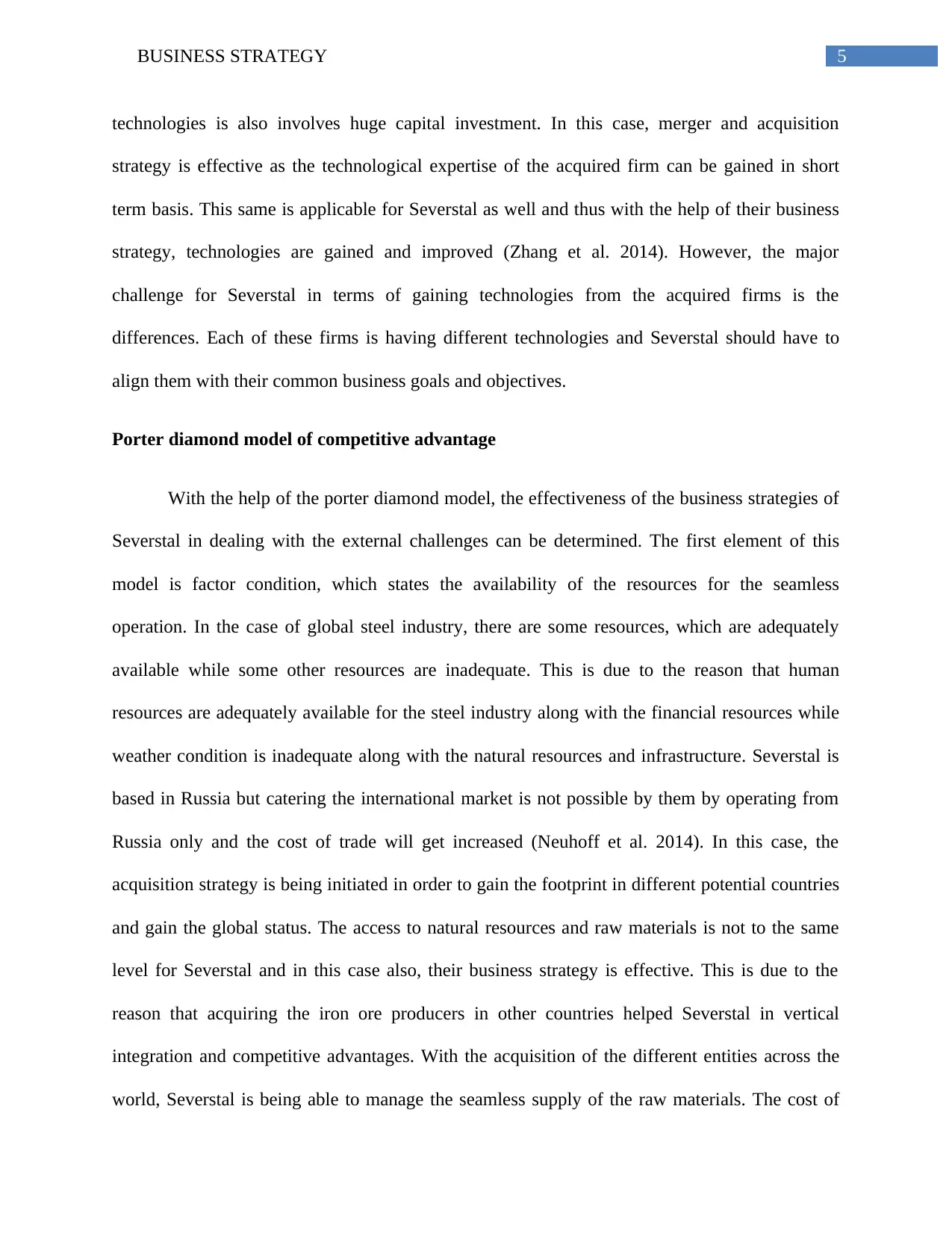
5BUSINESS STRATEGY
technologies is also involves huge capital investment. In this case, merger and acquisition
strategy is effective as the technological expertise of the acquired firm can be gained in short
term basis. This same is applicable for Severstal as well and thus with the help of their business
strategy, technologies are gained and improved (Zhang et al. 2014). However, the major
challenge for Severstal in terms of gaining technologies from the acquired firms is the
differences. Each of these firms is having different technologies and Severstal should have to
align them with their common business goals and objectives.
Porter diamond model of competitive advantage
With the help of the porter diamond model, the effectiveness of the business strategies of
Severstal in dealing with the external challenges can be determined. The first element of this
model is factor condition, which states the availability of the resources for the seamless
operation. In the case of global steel industry, there are some resources, which are adequately
available while some other resources are inadequate. This is due to the reason that human
resources are adequately available for the steel industry along with the financial resources while
weather condition is inadequate along with the natural resources and infrastructure. Severstal is
based in Russia but catering the international market is not possible by them by operating from
Russia only and the cost of trade will get increased (Neuhoff et al. 2014). In this case, the
acquisition strategy is being initiated in order to gain the footprint in different potential countries
and gain the global status. The access to natural resources and raw materials is not to the same
level for Severstal and in this case also, their business strategy is effective. This is due to the
reason that acquiring the iron ore producers in other countries helped Severstal in vertical
integration and competitive advantages. With the acquisition of the different entities across the
world, Severstal is being able to manage the seamless supply of the raw materials. The cost of
technologies is also involves huge capital investment. In this case, merger and acquisition
strategy is effective as the technological expertise of the acquired firm can be gained in short
term basis. This same is applicable for Severstal as well and thus with the help of their business
strategy, technologies are gained and improved (Zhang et al. 2014). However, the major
challenge for Severstal in terms of gaining technologies from the acquired firms is the
differences. Each of these firms is having different technologies and Severstal should have to
align them with their common business goals and objectives.
Porter diamond model of competitive advantage
With the help of the porter diamond model, the effectiveness of the business strategies of
Severstal in dealing with the external challenges can be determined. The first element of this
model is factor condition, which states the availability of the resources for the seamless
operation. In the case of global steel industry, there are some resources, which are adequately
available while some other resources are inadequate. This is due to the reason that human
resources are adequately available for the steel industry along with the financial resources while
weather condition is inadequate along with the natural resources and infrastructure. Severstal is
based in Russia but catering the international market is not possible by them by operating from
Russia only and the cost of trade will get increased (Neuhoff et al. 2014). In this case, the
acquisition strategy is being initiated in order to gain the footprint in different potential countries
and gain the global status. The access to natural resources and raw materials is not to the same
level for Severstal and in this case also, their business strategy is effective. This is due to the
reason that acquiring the iron ore producers in other countries helped Severstal in vertical
integration and competitive advantages. With the acquisition of the different entities across the
world, Severstal is being able to manage the seamless supply of the raw materials. The cost of
⊘ This is a preview!⊘
Do you want full access?
Subscribe today to unlock all pages.

Trusted by 1+ million students worldwide
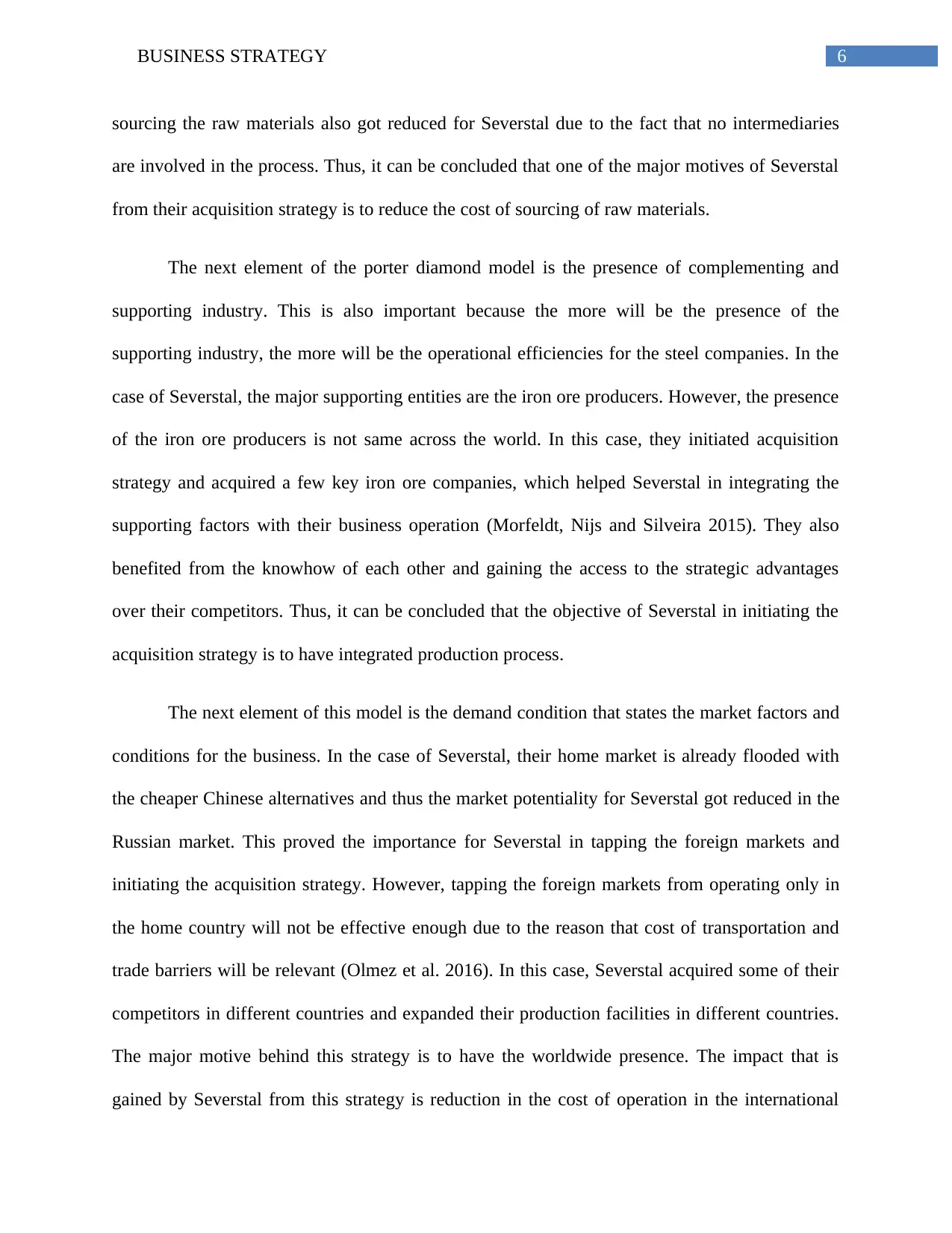
6BUSINESS STRATEGY
sourcing the raw materials also got reduced for Severstal due to the fact that no intermediaries
are involved in the process. Thus, it can be concluded that one of the major motives of Severstal
from their acquisition strategy is to reduce the cost of sourcing of raw materials.
The next element of the porter diamond model is the presence of complementing and
supporting industry. This is also important because the more will be the presence of the
supporting industry, the more will be the operational efficiencies for the steel companies. In the
case of Severstal, the major supporting entities are the iron ore producers. However, the presence
of the iron ore producers is not same across the world. In this case, they initiated acquisition
strategy and acquired a few key iron ore companies, which helped Severstal in integrating the
supporting factors with their business operation (Morfeldt, Nijs and Silveira 2015). They also
benefited from the knowhow of each other and gaining the access to the strategic advantages
over their competitors. Thus, it can be concluded that the objective of Severstal in initiating the
acquisition strategy is to have integrated production process.
The next element of this model is the demand condition that states the market factors and
conditions for the business. In the case of Severstal, their home market is already flooded with
the cheaper Chinese alternatives and thus the market potentiality for Severstal got reduced in the
Russian market. This proved the importance for Severstal in tapping the foreign markets and
initiating the acquisition strategy. However, tapping the foreign markets from operating only in
the home country will not be effective enough due to the reason that cost of transportation and
trade barriers will be relevant (Olmez et al. 2016). In this case, Severstal acquired some of their
competitors in different countries and expanded their production facilities in different countries.
The major motive behind this strategy is to have the worldwide presence. The impact that is
gained by Severstal from this strategy is reduction in the cost of operation in the international
sourcing the raw materials also got reduced for Severstal due to the fact that no intermediaries
are involved in the process. Thus, it can be concluded that one of the major motives of Severstal
from their acquisition strategy is to reduce the cost of sourcing of raw materials.
The next element of the porter diamond model is the presence of complementing and
supporting industry. This is also important because the more will be the presence of the
supporting industry, the more will be the operational efficiencies for the steel companies. In the
case of Severstal, the major supporting entities are the iron ore producers. However, the presence
of the iron ore producers is not same across the world. In this case, they initiated acquisition
strategy and acquired a few key iron ore companies, which helped Severstal in integrating the
supporting factors with their business operation (Morfeldt, Nijs and Silveira 2015). They also
benefited from the knowhow of each other and gaining the access to the strategic advantages
over their competitors. Thus, it can be concluded that the objective of Severstal in initiating the
acquisition strategy is to have integrated production process.
The next element of this model is the demand condition that states the market factors and
conditions for the business. In the case of Severstal, their home market is already flooded with
the cheaper Chinese alternatives and thus the market potentiality for Severstal got reduced in the
Russian market. This proved the importance for Severstal in tapping the foreign markets and
initiating the acquisition strategy. However, tapping the foreign markets from operating only in
the home country will not be effective enough due to the reason that cost of transportation and
trade barriers will be relevant (Olmez et al. 2016). In this case, Severstal acquired some of their
competitors in different countries and expanded their production facilities in different countries.
The major motive behind this strategy is to have the worldwide presence. The impact that is
gained by Severstal from this strategy is reduction in the cost of operation in the international
Paraphrase This Document
Need a fresh take? Get an instant paraphrase of this document with our AI Paraphraser
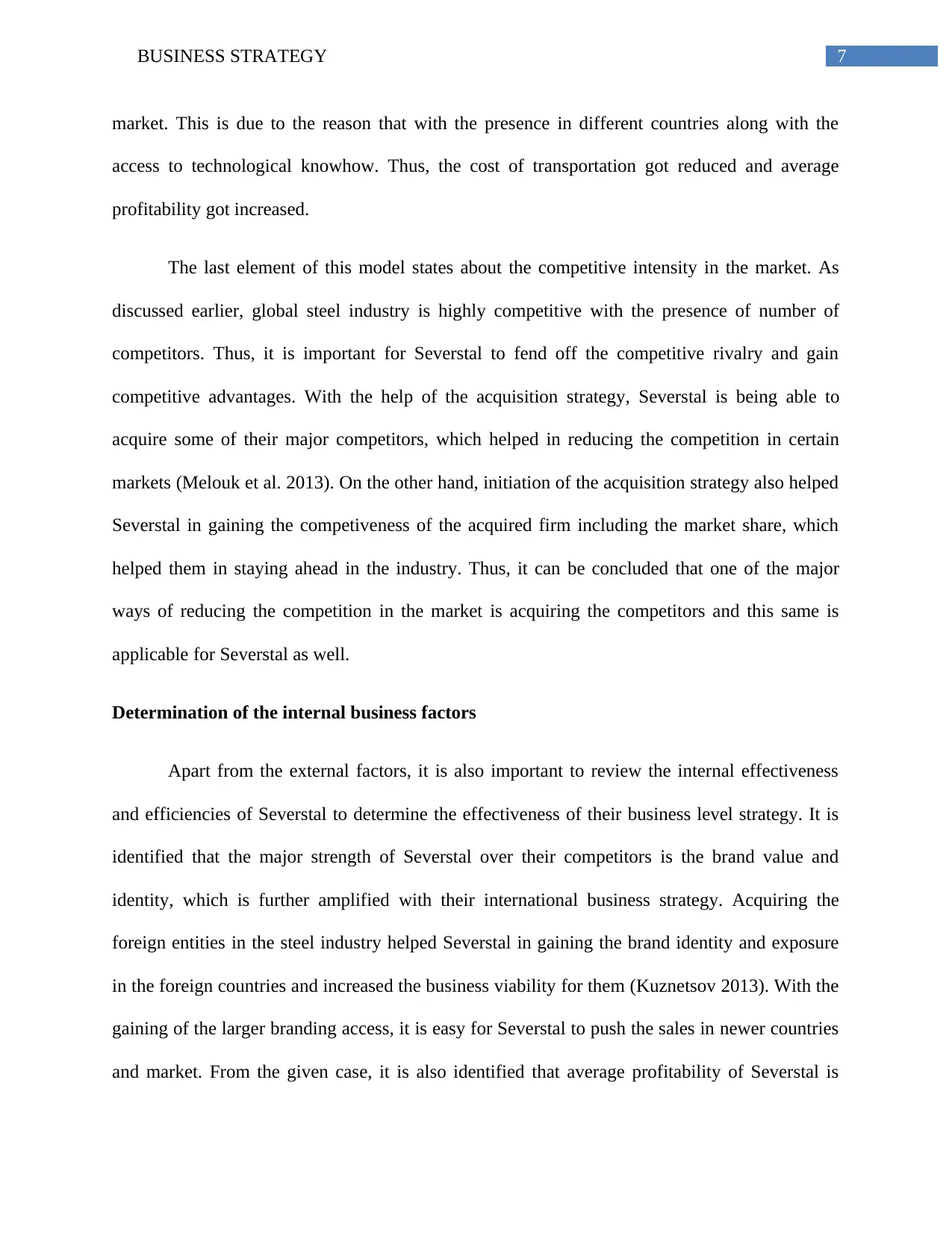
7BUSINESS STRATEGY
market. This is due to the reason that with the presence in different countries along with the
access to technological knowhow. Thus, the cost of transportation got reduced and average
profitability got increased.
The last element of this model states about the competitive intensity in the market. As
discussed earlier, global steel industry is highly competitive with the presence of number of
competitors. Thus, it is important for Severstal to fend off the competitive rivalry and gain
competitive advantages. With the help of the acquisition strategy, Severstal is being able to
acquire some of their major competitors, which helped in reducing the competition in certain
markets (Melouk et al. 2013). On the other hand, initiation of the acquisition strategy also helped
Severstal in gaining the competiveness of the acquired firm including the market share, which
helped them in staying ahead in the industry. Thus, it can be concluded that one of the major
ways of reducing the competition in the market is acquiring the competitors and this same is
applicable for Severstal as well.
Determination of the internal business factors
Apart from the external factors, it is also important to review the internal effectiveness
and efficiencies of Severstal to determine the effectiveness of their business level strategy. It is
identified that the major strength of Severstal over their competitors is the brand value and
identity, which is further amplified with their international business strategy. Acquiring the
foreign entities in the steel industry helped Severstal in gaining the brand identity and exposure
in the foreign countries and increased the business viability for them (Kuznetsov 2013). With the
gaining of the larger branding access, it is easy for Severstal to push the sales in newer countries
and market. From the given case, it is also identified that average profitability of Severstal is
market. This is due to the reason that with the presence in different countries along with the
access to technological knowhow. Thus, the cost of transportation got reduced and average
profitability got increased.
The last element of this model states about the competitive intensity in the market. As
discussed earlier, global steel industry is highly competitive with the presence of number of
competitors. Thus, it is important for Severstal to fend off the competitive rivalry and gain
competitive advantages. With the help of the acquisition strategy, Severstal is being able to
acquire some of their major competitors, which helped in reducing the competition in certain
markets (Melouk et al. 2013). On the other hand, initiation of the acquisition strategy also helped
Severstal in gaining the competiveness of the acquired firm including the market share, which
helped them in staying ahead in the industry. Thus, it can be concluded that one of the major
ways of reducing the competition in the market is acquiring the competitors and this same is
applicable for Severstal as well.
Determination of the internal business factors
Apart from the external factors, it is also important to review the internal effectiveness
and efficiencies of Severstal to determine the effectiveness of their business level strategy. It is
identified that the major strength of Severstal over their competitors is the brand value and
identity, which is further amplified with their international business strategy. Acquiring the
foreign entities in the steel industry helped Severstal in gaining the brand identity and exposure
in the foreign countries and increased the business viability for them (Kuznetsov 2013). With the
gaining of the larger branding access, it is easy for Severstal to push the sales in newer countries
and market. From the given case, it is also identified that average profitability of Severstal is
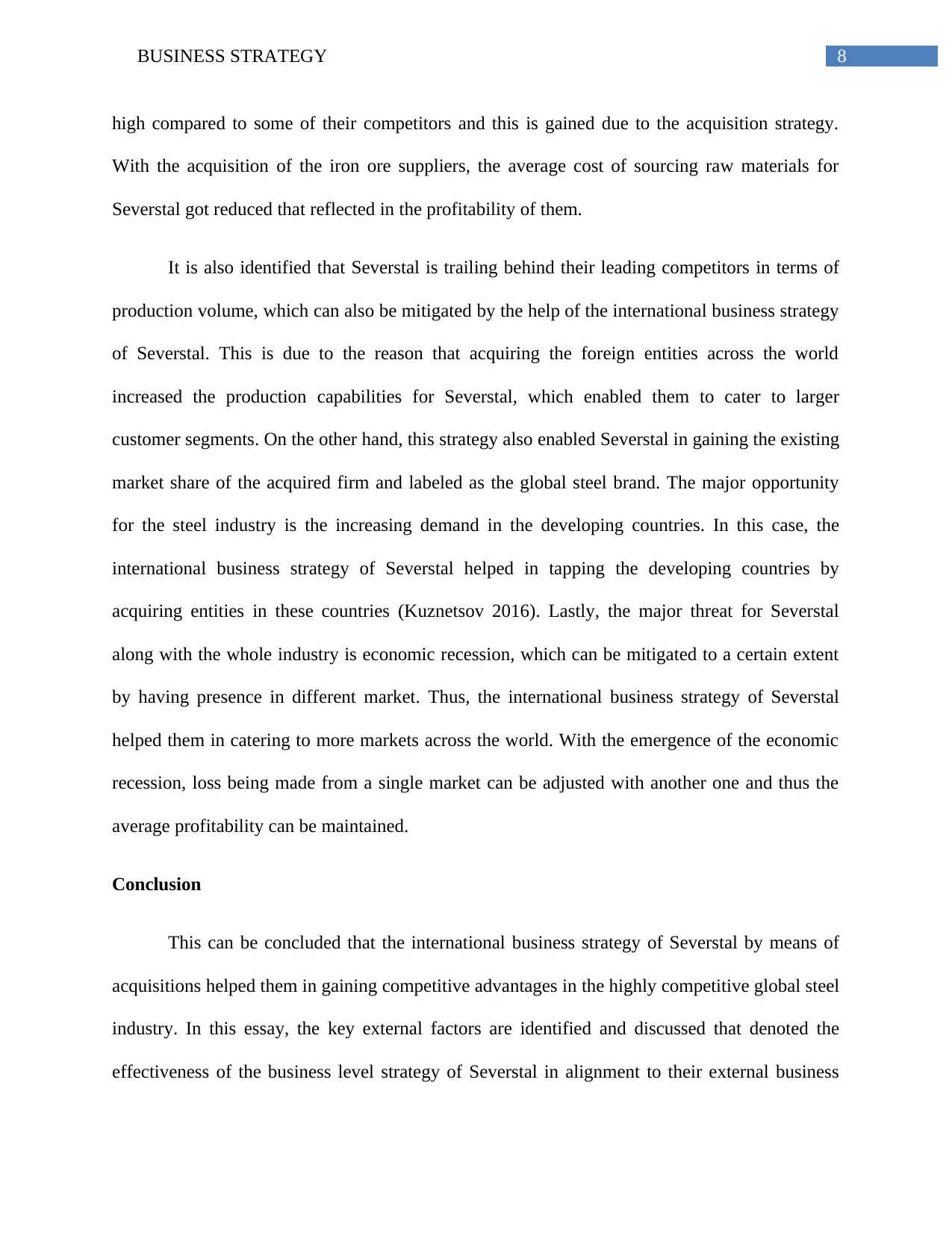
8BUSINESS STRATEGY
high compared to some of their competitors and this is gained due to the acquisition strategy.
With the acquisition of the iron ore suppliers, the average cost of sourcing raw materials for
Severstal got reduced that reflected in the profitability of them.
It is also identified that Severstal is trailing behind their leading competitors in terms of
production volume, which can also be mitigated by the help of the international business strategy
of Severstal. This is due to the reason that acquiring the foreign entities across the world
increased the production capabilities for Severstal, which enabled them to cater to larger
customer segments. On the other hand, this strategy also enabled Severstal in gaining the existing
market share of the acquired firm and labeled as the global steel brand. The major opportunity
for the steel industry is the increasing demand in the developing countries. In this case, the
international business strategy of Severstal helped in tapping the developing countries by
acquiring entities in these countries (Kuznetsov 2016). Lastly, the major threat for Severstal
along with the whole industry is economic recession, which can be mitigated to a certain extent
by having presence in different market. Thus, the international business strategy of Severstal
helped them in catering to more markets across the world. With the emergence of the economic
recession, loss being made from a single market can be adjusted with another one and thus the
average profitability can be maintained.
Conclusion
This can be concluded that the international business strategy of Severstal by means of
acquisitions helped them in gaining competitive advantages in the highly competitive global steel
industry. In this essay, the key external factors are identified and discussed that denoted the
effectiveness of the business level strategy of Severstal in alignment to their external business
high compared to some of their competitors and this is gained due to the acquisition strategy.
With the acquisition of the iron ore suppliers, the average cost of sourcing raw materials for
Severstal got reduced that reflected in the profitability of them.
It is also identified that Severstal is trailing behind their leading competitors in terms of
production volume, which can also be mitigated by the help of the international business strategy
of Severstal. This is due to the reason that acquiring the foreign entities across the world
increased the production capabilities for Severstal, which enabled them to cater to larger
customer segments. On the other hand, this strategy also enabled Severstal in gaining the existing
market share of the acquired firm and labeled as the global steel brand. The major opportunity
for the steel industry is the increasing demand in the developing countries. In this case, the
international business strategy of Severstal helped in tapping the developing countries by
acquiring entities in these countries (Kuznetsov 2016). Lastly, the major threat for Severstal
along with the whole industry is economic recession, which can be mitigated to a certain extent
by having presence in different market. Thus, the international business strategy of Severstal
helped them in catering to more markets across the world. With the emergence of the economic
recession, loss being made from a single market can be adjusted with another one and thus the
average profitability can be maintained.
Conclusion
This can be concluded that the international business strategy of Severstal by means of
acquisitions helped them in gaining competitive advantages in the highly competitive global steel
industry. In this essay, the key external factors are identified and discussed that denoted the
effectiveness of the business level strategy of Severstal in alignment to their external business
⊘ This is a preview!⊘
Do you want full access?
Subscribe today to unlock all pages.

Trusted by 1+ million students worldwide
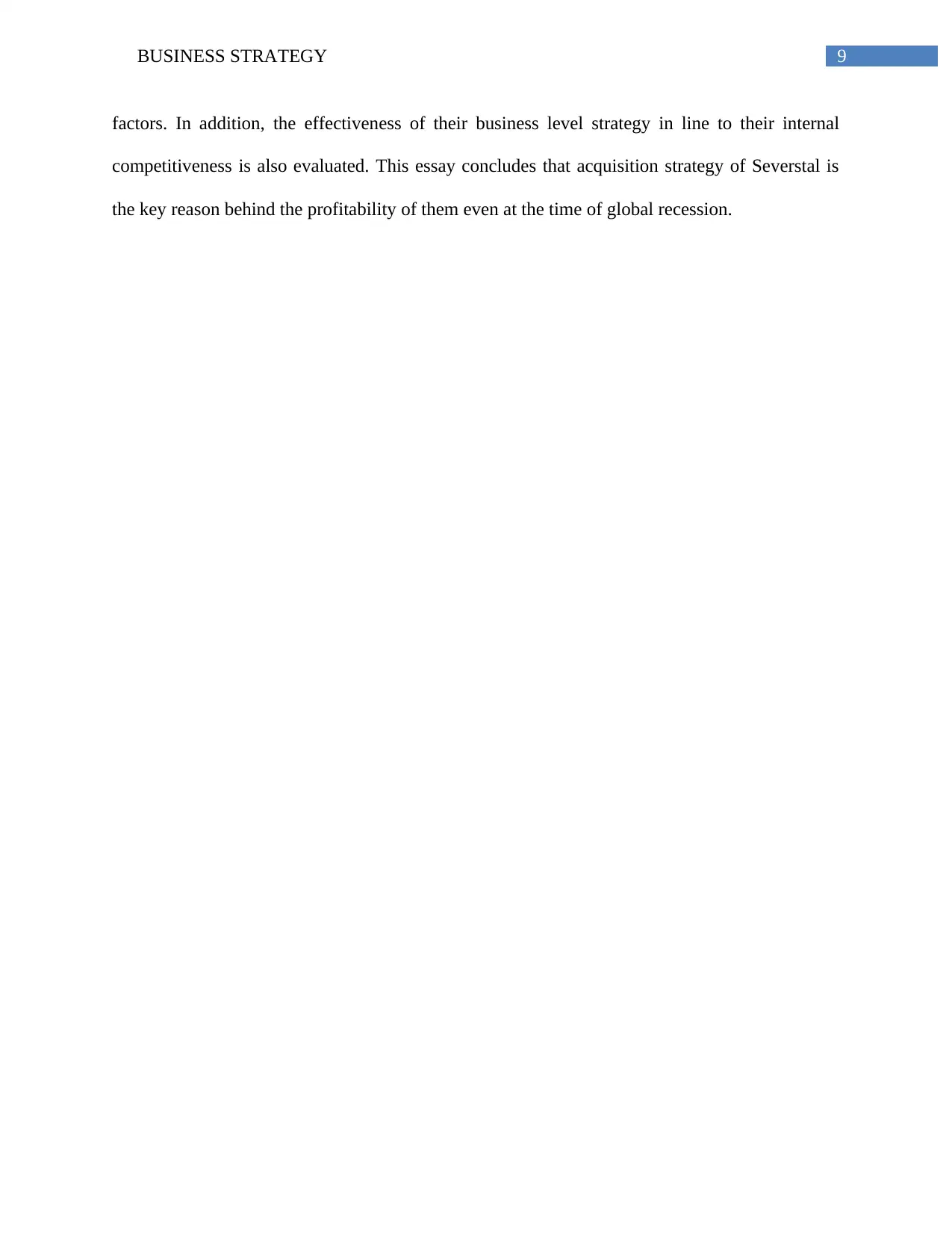
9BUSINESS STRATEGY
factors. In addition, the effectiveness of their business level strategy in line to their internal
competitiveness is also evaluated. This essay concludes that acquisition strategy of Severstal is
the key reason behind the profitability of them even at the time of global recession.
factors. In addition, the effectiveness of their business level strategy in line to their internal
competitiveness is also evaluated. This essay concludes that acquisition strategy of Severstal is
the key reason behind the profitability of them even at the time of global recession.
Paraphrase This Document
Need a fresh take? Get an instant paraphrase of this document with our AI Paraphraser
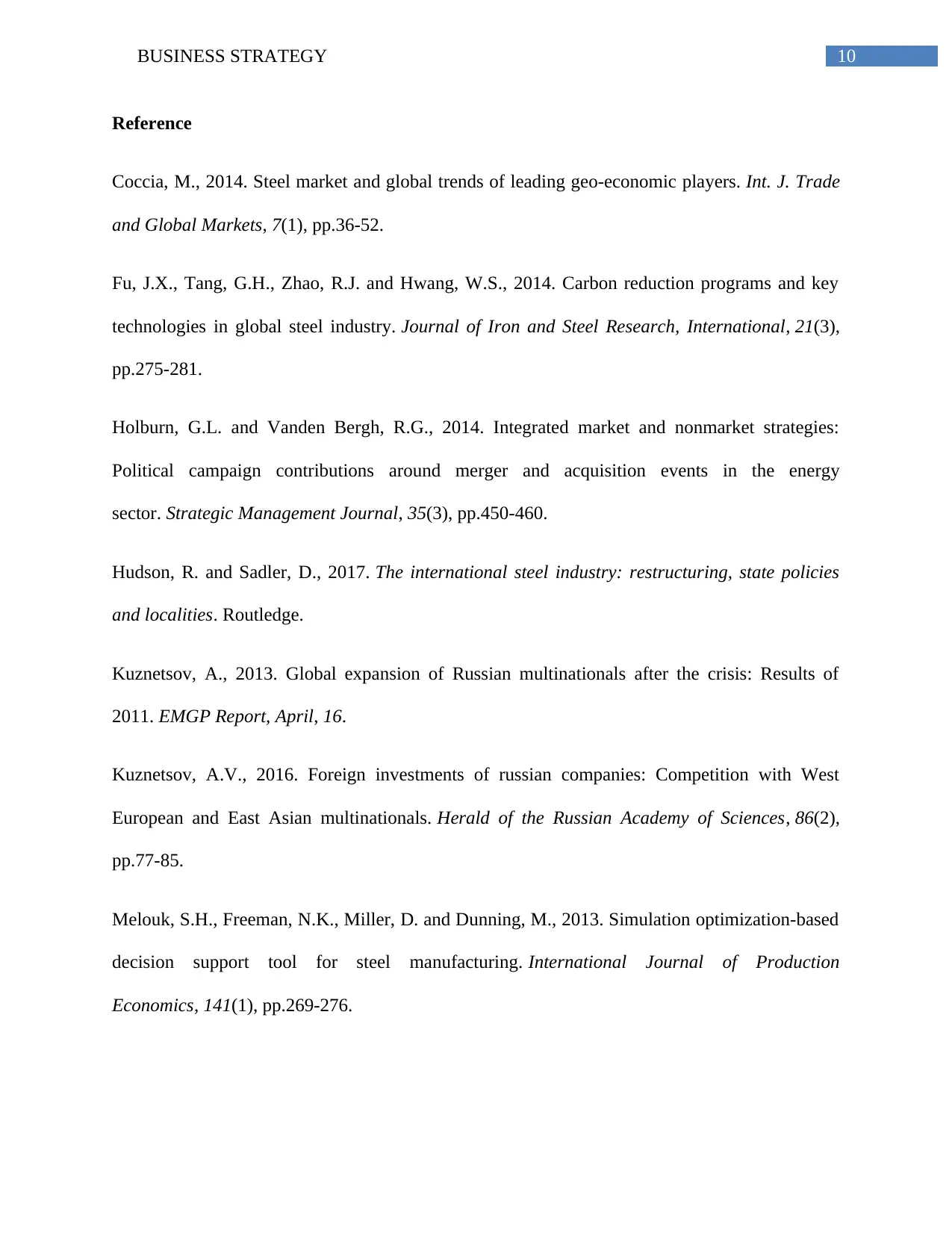
10BUSINESS STRATEGY
Reference
Coccia, M., 2014. Steel market and global trends of leading geo-economic players. Int. J. Trade
and Global Markets, 7(1), pp.36-52.
Fu, J.X., Tang, G.H., Zhao, R.J. and Hwang, W.S., 2014. Carbon reduction programs and key
technologies in global steel industry. Journal of Iron and Steel Research, International, 21(3),
pp.275-281.
Holburn, G.L. and Vanden Bergh, R.G., 2014. Integrated market and nonmarket strategies:
Political campaign contributions around merger and acquisition events in the energy
sector. Strategic Management Journal, 35(3), pp.450-460.
Hudson, R. and Sadler, D., 2017. The international steel industry: restructuring, state policies
and localities. Routledge.
Kuznetsov, A., 2013. Global expansion of Russian multinationals after the crisis: Results of
2011. EMGP Report, April, 16.
Kuznetsov, A.V., 2016. Foreign investments of russian companies: Competition with West
European and East Asian multinationals. Herald of the Russian Academy of Sciences, 86(2),
pp.77-85.
Melouk, S.H., Freeman, N.K., Miller, D. and Dunning, M., 2013. Simulation optimization-based
decision support tool for steel manufacturing. International Journal of Production
Economics, 141(1), pp.269-276.
Reference
Coccia, M., 2014. Steel market and global trends of leading geo-economic players. Int. J. Trade
and Global Markets, 7(1), pp.36-52.
Fu, J.X., Tang, G.H., Zhao, R.J. and Hwang, W.S., 2014. Carbon reduction programs and key
technologies in global steel industry. Journal of Iron and Steel Research, International, 21(3),
pp.275-281.
Holburn, G.L. and Vanden Bergh, R.G., 2014. Integrated market and nonmarket strategies:
Political campaign contributions around merger and acquisition events in the energy
sector. Strategic Management Journal, 35(3), pp.450-460.
Hudson, R. and Sadler, D., 2017. The international steel industry: restructuring, state policies
and localities. Routledge.
Kuznetsov, A., 2013. Global expansion of Russian multinationals after the crisis: Results of
2011. EMGP Report, April, 16.
Kuznetsov, A.V., 2016. Foreign investments of russian companies: Competition with West
European and East Asian multinationals. Herald of the Russian Academy of Sciences, 86(2),
pp.77-85.
Melouk, S.H., Freeman, N.K., Miller, D. and Dunning, M., 2013. Simulation optimization-based
decision support tool for steel manufacturing. International Journal of Production
Economics, 141(1), pp.269-276.
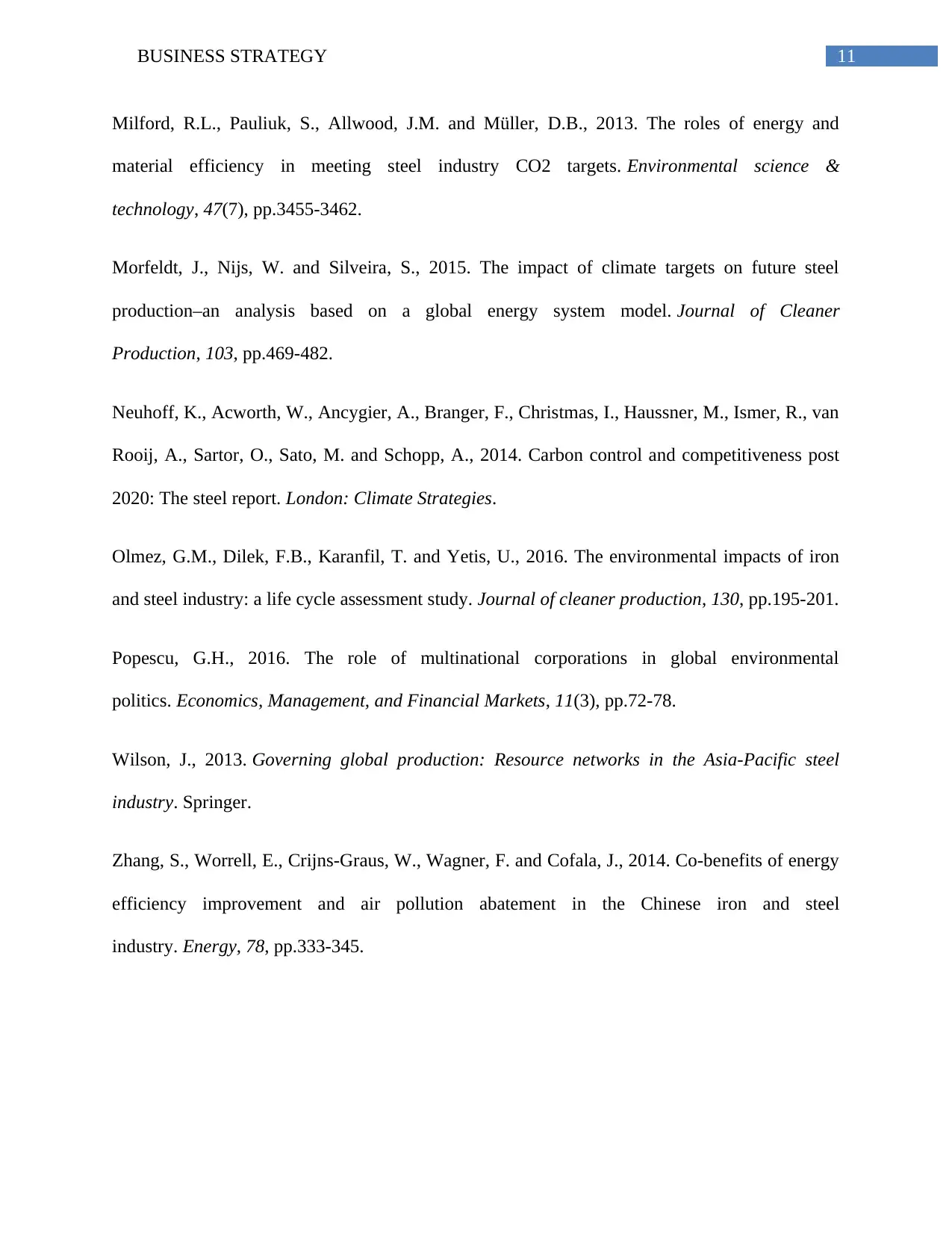
11BUSINESS STRATEGY
Milford, R.L., Pauliuk, S., Allwood, J.M. and Müller, D.B., 2013. The roles of energy and
material efficiency in meeting steel industry CO2 targets. Environmental science &
technology, 47(7), pp.3455-3462.
Morfeldt, J., Nijs, W. and Silveira, S., 2015. The impact of climate targets on future steel
production–an analysis based on a global energy system model. Journal of Cleaner
Production, 103, pp.469-482.
Neuhoff, K., Acworth, W., Ancygier, A., Branger, F., Christmas, I., Haussner, M., Ismer, R., van
Rooij, A., Sartor, O., Sato, M. and Schopp, A., 2014. Carbon control and competitiveness post
2020: The steel report. London: Climate Strategies.
Olmez, G.M., Dilek, F.B., Karanfil, T. and Yetis, U., 2016. The environmental impacts of iron
and steel industry: a life cycle assessment study. Journal of cleaner production, 130, pp.195-201.
Popescu, G.H., 2016. The role of multinational corporations in global environmental
politics. Economics, Management, and Financial Markets, 11(3), pp.72-78.
Wilson, J., 2013. Governing global production: Resource networks in the Asia-Pacific steel
industry. Springer.
Zhang, S., Worrell, E., Crijns-Graus, W., Wagner, F. and Cofala, J., 2014. Co-benefits of energy
efficiency improvement and air pollution abatement in the Chinese iron and steel
industry. Energy, 78, pp.333-345.
Milford, R.L., Pauliuk, S., Allwood, J.M. and Müller, D.B., 2013. The roles of energy and
material efficiency in meeting steel industry CO2 targets. Environmental science &
technology, 47(7), pp.3455-3462.
Morfeldt, J., Nijs, W. and Silveira, S., 2015. The impact of climate targets on future steel
production–an analysis based on a global energy system model. Journal of Cleaner
Production, 103, pp.469-482.
Neuhoff, K., Acworth, W., Ancygier, A., Branger, F., Christmas, I., Haussner, M., Ismer, R., van
Rooij, A., Sartor, O., Sato, M. and Schopp, A., 2014. Carbon control and competitiveness post
2020: The steel report. London: Climate Strategies.
Olmez, G.M., Dilek, F.B., Karanfil, T. and Yetis, U., 2016. The environmental impacts of iron
and steel industry: a life cycle assessment study. Journal of cleaner production, 130, pp.195-201.
Popescu, G.H., 2016. The role of multinational corporations in global environmental
politics. Economics, Management, and Financial Markets, 11(3), pp.72-78.
Wilson, J., 2013. Governing global production: Resource networks in the Asia-Pacific steel
industry. Springer.
Zhang, S., Worrell, E., Crijns-Graus, W., Wagner, F. and Cofala, J., 2014. Co-benefits of energy
efficiency improvement and air pollution abatement in the Chinese iron and steel
industry. Energy, 78, pp.333-345.
⊘ This is a preview!⊘
Do you want full access?
Subscribe today to unlock all pages.

Trusted by 1+ million students worldwide
1 out of 12
Related Documents
Your All-in-One AI-Powered Toolkit for Academic Success.
+13062052269
info@desklib.com
Available 24*7 on WhatsApp / Email
![[object Object]](/_next/static/media/star-bottom.7253800d.svg)
Unlock your academic potential
Copyright © 2020–2025 A2Z Services. All Rights Reserved. Developed and managed by ZUCOL.





